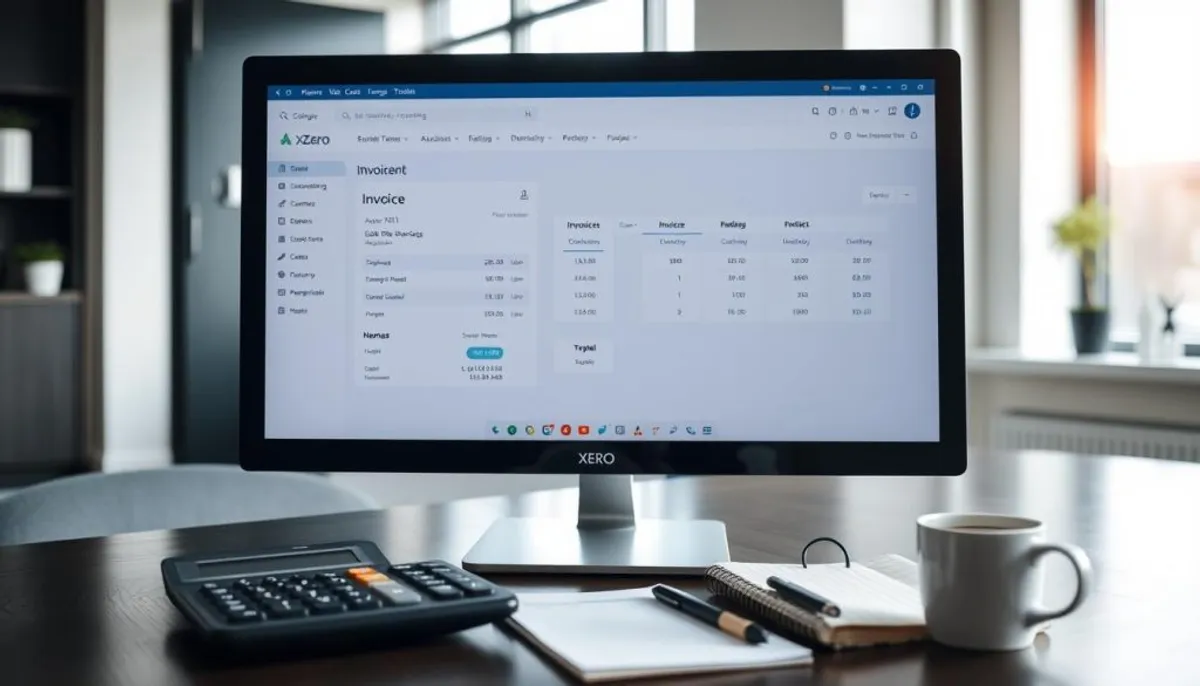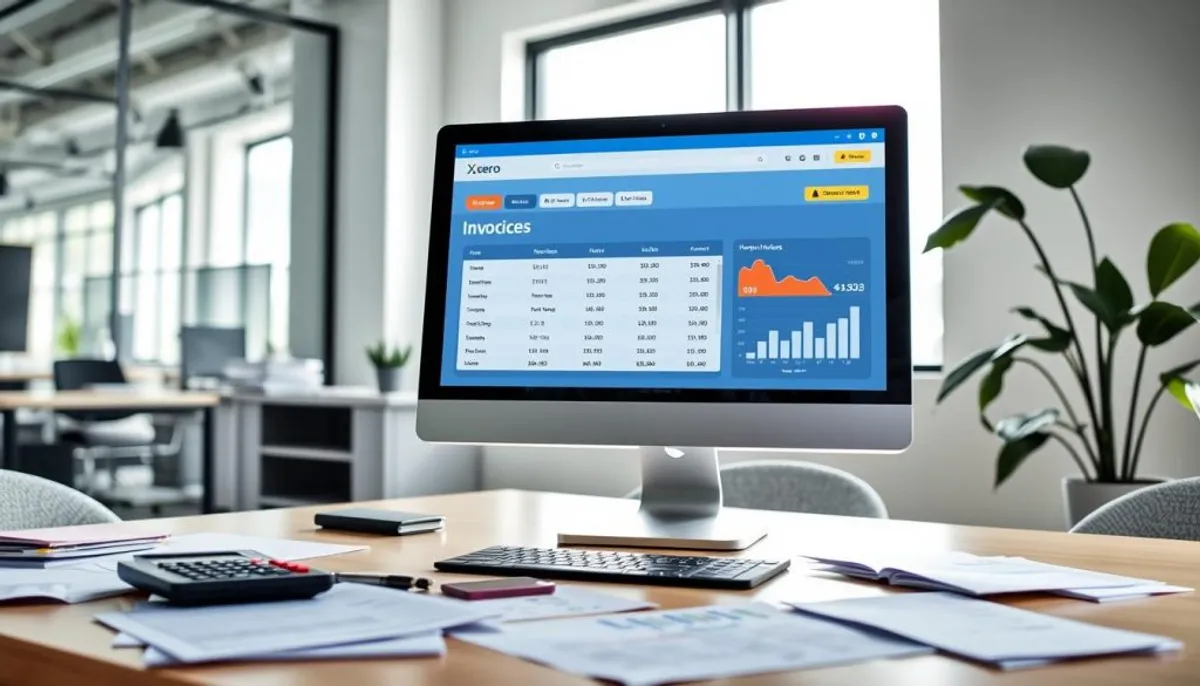Managing unpaid customer invoices can be a significant challenge for business owners. Xero accounting software provides a solution to these financial issues. This guide will show you how to write off unpaid invoices in Xero, ensuring your financial records remain accurate and your cash flow is maintained.
Unpaid invoices can severely hinder your business operations. In fact, 42% of businesses face outstanding invoices that are unlikely to be paid. Thus, having a robust strategy for handling these situations is essential.

Xero’s advanced features simplify tracking, managing, and writing off unpaid invoices. It offers tools for creating customized invoice templates and setting up automated reminders. These tools help you stay in control of your accounts receivable.
This guide will cover steps to write off bad debts, implement late payment fees, and prevent future unpaid invoices. We will also discuss legal considerations and best practices for maintaining healthy client relationships while safeguarding your financial interests.
Key Takeaways
- Unpaid invoices can significantly disrupt cash flow and business operations
- Xero offers features to create, track, and manage invoices effectively
- Setting up automated reminders can lead to faster invoice payments
- Implementing late payment fees can incentivize clients to pay on time
- Credit checks on new clients can help prevent future unpaid invoices
- Proper accounting for bad debts is crucial for accurate financial reporting
Understanding Unpaid Invoices and Their Impact on Business
Unpaid invoices can severely damage a business’s financial stability. For small businesses, managing accounts receivable is paramount. We will examine how outstanding invoices affect businesses and why proper management is critical.
The financial strain of outstanding invoices
Late payments pose significant challenges for businesses. In the US, companies typically wait 28.9 days for invoice payments. This delay can severely impact cash flow, making it difficult to cover operating costs and plan for future expenses.
Effects on cash flow and business relationships
Unpaid invoices not only disrupt cash flow but also strain relationships with suppliers and impact credit ratings. To mitigate these issues, businesses can implement strategies like offering online payment options. This can lead to faster settlements, sometimes up to twice as quick.
Importance of managing unpaid invoices
Effective accounts receivable management is crucial for long-term financial stability. Prompt action on overdue invoices helps maintain professional relationships and ensures steady cash flow. Consider these strategies for managing unpaid invoices:
- Use online invoicing software to automate reminders and track payments
- Implement progress billing for large projects
- Explore invoice financing options for immediate cash flow
| Invoice Management Method | Benefit |
|---|---|
| Online Payment Options | Up to 2x faster settlements |
| Automated Reminders | Improved collection rates |
| Progress Billing | Increased likelihood of partial payments |
| Invoice Financing | Immediate access to up to 85% of invoice value |
By understanding the impact of unpaid invoices and implementing effective management strategies, businesses can improve their financial health. This reduces the need for writing off bad debts.
Initial Steps to Recover Unpaid Invoices
Initiating the process of reducing outstanding invoices necessitates a proactive stance. Begin by dispatching a courteous payment request, either via letter or email. Ensure to include precise invoice details, such as the invoice number, due date, and the amount due. This approach often elicits prompt payment from clients who may have forgotten.
Should the initial request fail to elicit a response, escalate the matter with an overdue invoice. Mark it clearly as “overdue” to instill a sense of urgency. This visual indicator can prompt clients to prioritize your payment. It is essential to balance the need to collect overdue payments with the goal of preserving positive client relationships.
Establishing an invoice reminder schedule is vital for effective cash flow management. This can be achieved manually or through the use of automated invoicing software. Xero Accounting Software, for instance, enables businesses to automate payment reminders via email. This feature aids in tracking overdue invoices and managing late payments, ensuring clients are promptly informed of missed payments.
For clients with multiple unpaid invoices, consider issuing a statement of accounts. This detailed summary of all outstanding payments provides a comprehensive view of the debt. It simplifies the understanding and resolution of client obligations.
| Strategy | Effectiveness | Time Investment |
|---|---|---|
| Polite Payment Request | Moderate | Low |
| Overdue Invoice Stamp | High | Low |
| Automated Reminders | Very High | Initial setup, then minimal |
| Statement of Accounts | High | Moderate |
By adopting these strategies, businesses can significantly enhance their chances of recovering unpaid invoices. In fact, integrating Xero with advanced collection tools like Kolleno has been shown to achieve over 90% payment rate recovery. This is due to the streamlined payment processes facilitated by such tools.
Utilizing Xero’s Invoicing Features
Xero accounting software boasts a suite of advanced invoicing tools designed to simplify your billing workflow. Its intuitive interface empowers you to generate professional invoices and manage payment transactions with ease.
Creating and Sending Invoices
Xero’s invoicing capabilities include customizable templates, allowing you to integrate your logo and specify payment terms. Crafting invoices is a swift process, saving you valuable time and ensuring a unified brand presence. The platform accommodates a variety of payment methods, including credit cards and bank transfers, enhancing the convenience for your clients.

Setting Up Automated Reminders
Xero facilitates the setup of automatic reminders to minimize late payments. You can tailor reminder frequencies to suit your needs, ranging from daily to specific intervals. This feature automates client communication, enhancing your cash flow management without manual oversight.
Tracking Payment Times
Xero’s sales overview offers real-time insights into pending and paid invoices, along with the total amounts due. It enables you to monitor hours worked and track invoice statuses accurately, ensuring precise billing for services rendered. The system’s reporting tools, such as the Aged Receivables Summary, provide critical data for effective management of overdue invoices.
- Create recurring invoice templates for regular billing
- Use the mobile app to send invoices on-the-go
- Import invoices from other systems using CSV files
- Offer early payment discounts to incentivize timely payments
By harnessing these Xero invoicing features, you can dramatically enhance your invoicing process and sustain a healthy cash flow for your enterprise.
Effective Strategies for Chasing Overdue Payments
Handling overdue payments is a common challenge for businesses. Studies reveal that 87% of companies face late payments, with three in five UK SMEs waiting on unpaid invoices. This situation can strain cash flow and business relationships.
To tackle this issue, consider these strategies for reducing outstanding invoices:
- Send automated reminders via email and SMS
- Make direct phone calls to clients
- Offer flexible payment plans
- Implement late payment fees
Businesses using automated invoice reminders get paid up to 54 days sooner. Combining SMS and email reminders increases the chance of payment within a week by 56%. For persistent cases, direct phone calls can be effective. Prepare a conversation structure, mentioning specific unpaid invoices and politely requesting a payment date.
If uncomfortable with negotiations, consider delegating this task to a bookkeeper or accountant. Remember, 80% of unpaid invoices can be collected through email chasing alone, making it a powerful tool in your arsenal for handling overdue payments.
| Strategy | Effectiveness | Time Saved |
|---|---|---|
| Automated Reminders | 54 days faster payment | 4+ hours weekly |
| SMS + Email Reminders | 56% higher payment rate | 2-3 hours weekly |
| Direct Phone Calls | High for persistent cases | 1-2 hours per call |
Implementing Late Payment Fees in Xero
Xero accounting software provides robust tools for managing overdue payments. Establishing late payment fees can incentivize timely payments, thus enhancing cash flow. We will examine the process of integrating this feature effectively.
Setting up Late Payment Policies
Establish a distinct late payment policy within Xero. Opt for a fee ranging from 1% to 1.5% of the outstanding amount. This method strikes a balance between fairness and the motivation for prompt payment. It is crucial to aim for timely payments, not to penalize clients.
Communicating Fee Structures to Clients
Transparency is paramount when introducing late fees. Clearly outline your policy on invoices and within your terms of service. This proactive communication helps avoid misinterpretations and fosters strong client relationships.
Applying Late Fees in Xero
Xero facilitates the automatic application of late fees. Configure the system to add fees after a specified period, typically 7 to 14 days after the due date. This automation not only saves time but also ensures consistent enforcement of your policy.
| Payment Terms | Average Settlement Time | Recommended Late Fee |
|---|---|---|
| 1 week | 2 weeks | 1% |
| 2 weeks | 2-3 weeks | 1.25% |
| 3-4 weeks | 1 month | 1.5% |
By integrating late payment fees in Xero, you can significantly reduce the time spent on chasing unpaid invoices. This move not only improves your cash flow but also fosters a positive client relationship. A fair and clearly communicated policy is essential for achieving these goals.
When to Consider Stopping Work for Non-Paying Clients
Managing accounts receivable for small businesses can be daunting, notably with clients who fail to pay. It is imperative to discern the appropriate moment to cease work for such clients. This action safeguards your enterprise and fortifies your accounts receivable management practices.

- Payment history: Review the client’s past payment behavior
- Communication: Assess their responsiveness to payment reminders
- Impact on cash flow: Evaluate how unpaid invoices affect your business operations
- Project status: Determine the current stage of work and potential consequences of stopping
Should you choose to suspend work, communicate this decision to the client in a clear, professional manner. Indicate that services will be reinstated upon settlement of outstanding invoices. This stance may jeopardize the client relationship. Yet, it is crucial for preserving financial health and stability.
Effective accounts receivable management is fundamental to the prosperity of small businesses. Addressing non-paying clients swiftly safeguards your business from financial distress. It ensures resources are directed towards profitable endeavors.
How to Write Off Unpaid Invoices in Xero
Writing off bad debts is a critical task in accounting for uncollectible debts. Xero streamlines this process, making it efficient to handle unpaid invoices. Let’s dive into the step-by-step guide on how to write off unpaid invoices in Xero.
Setting Up Your Bad Debts Account
To initiate the process, you must first set up a bad debts account in Xero. Access the Chart of Accounts and create a new account. Designate it as an “Expense” and name it “Bad Debts.” Ensure the tax code is set to “GST on Expenses” for precise tracking.
Writing Off Uncollectible Invoices
To write off an unpaid invoice, follow these steps:
- Go to Business > Invoices in Xero
- Locate the unpaid invoice you want to write off
- Click “Invoice Options” and select “Add Credit Note”
- Fill in the necessary details and allocate the amount to your Bad Debts account
- Save and approve the credit note
Adjusting Financial Reports
After writing off bad debts, your financial reports will automatically update. The bad debt amount will be reflected as an expense on your Profit and Loss statement. Your Accounts Receivable balance will also decrease on the Balance Sheet. Regularly reviewing these reports ensures accurate financial records.
| Frequency of Write-Offs | Recovery Possibility |
|---|---|
| As needed | Possible in some cases |
By adhering to these steps, you can effectively manage unpaid invoices and maintain accurate financial records in Xero.
Legal Considerations for Writing Off Bad Debts
Writing off bad debts and accounting for uncollectible debts involve significant legal considerations. Small business owners must navigate these complexities with care. This ensures compliance with tax regulations and accounting standards.
To write off unpaid invoices, businesses must adhere to specific criteria. They must have recorded the invoices in their accounting system and be accrual-basis taxpayers. It is crucial to prove to the IRS that reasonable steps were taken to collect payment.
The likelihood of future payment is a key factor in determining eligibility for write-offs. Businesses should consider writing off bad debts when there’s no reasonable chance of payment. This decision can significantly impact financial statements and tax obligations.
| Consideration | Impact |
|---|---|
| Recording in accounting system | Required for write-off eligibility |
| Accrual-basis taxpayer status | Necessary for IRS compliance |
| Proof of collection efforts | Essential for justifying write-offs |
| Future payment likelihood | Determines write-off timing |
It’s important to note that writing off a debt doesn’t mean giving up on collection efforts. Businesses may still send reminders or pursue legal action if the amount owed surpasses a significant threshold. Understanding these legal aspects is vital for proper accounting of uncollectible debts and maintaining financial health.
Preventing Future Unpaid Invoices
Ensuring timely payment is crucial for maintaining a stable cash flow. By implementing proactive measures, you can significantly reduce the risk of late payments and avoid write-offs. This approach is essential for the financial health of your business.
Conducting credit checks on new clients
Assessing a new client’s payment history is a prudent step before engaging them. Credit checks can uncover potential issues, guiding your decision-making process. This strategy not only protects your business but also prevents future financial stress.
Implementing upfront payment policies
Requesting partial payments upfront, for both large projects and long-term contracts, is advisable. This method ensures a consistent cash flow and minimizes the risk of non-payment. Clearly outlining payment terms from the outset fosters trust and enhances business relationships.
Offering payment plans to struggling clients
Flexible payment options can be beneficial for clients facing financial challenges. By breaking down large invoices into smaller, more manageable payments, you help clients stay on track. This approach demonstrates empathy and can foster loyalty, potentially leading to increased business opportunities.
RelatedRelated articles



